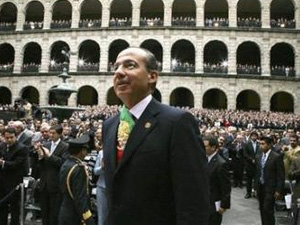 |
 |
 |
 Editorials | September 2007 Editorials | September 2007  
The Day of the President
 S. Lynne Walker - Copley News Service S. Lynne Walker - Copley News Service
go to original


| | In this handout picture released by Mexico's Presidency Office, Mexico's President Felipe Calderon arrives to the National Palace to give his state-of-the-nation address in Mexico City Sunday. (AP) |
While President Felipe Calderón ticked off his “to-do” list before a handpicked crowd in the National Palace Sunday, riot police and chanting protesters outside reminded Mexicans their democracy is still fragile.

Calderón delivered his first State of the Nation address with all the usual promises: a frontal attack on organized crime, attention to the needs of Mexico's 45 million poor and the pro-forma demand that the United States reform its immigration policy.

But this speech was different.

The president was blocked by leftist lawmakers from giving the annual address Saturday to the Mexican Congress. So Calderón chose the National Palace, a historic downtown Mexico City building where the murals of artist Diego Rivera grace the walls and where rival leftist candidate Andrés Manuel López Obrador vowed during the 2006 presidential campaign to conduct the business of his government.

That brought Ana María Olivares, 74, into the streets yesterday. “This is a farce,” the retired bank teller said as she pushed her wire-rimmed glasses up on her nose. “Felipe Calderón said he was going to be the jobs president, but every day in Mexico, there is more unemployment, more misery.” Olivares isn't the only Mexican who is unhappy with Calderón and his National Action Party during his first nine months in office.

Although his approval rating averages 65 percent, according to a poll published Saturday in the Mexico City daily Reforma, the country is divided in its opinion about the president. In Mexico City and in southern states, where most of Mexico's poor and indigenous people live, his rating is lower.

Calderón acknowledged the Mexican government has not done enough for the poor. He spoke poignantly of the contrast between the infant mortality rate in a rich community in the northern state of Nuevo Leon – 3 deaths per 1,000 – and the tragic rate – 78 deaths per 1,000 – in a poor indigenous community in the border state of Chihuahua.

“We owe an enormous debt to the poor,” Calderón said as he stood in the courtyard of the colonial palace.

To appease Mexicans who are angry about the outcome of the presidential election, Calderón said he favors reforming the system that gave him a narrow 0.56 percent victory over López Obrador and his Democratic Revolution Party.

His speech was interrupted at least a dozen times, not by the catcalls and critical banners that have marred every State of the Nation address the past two decades, but by applause from his invited audience. Once, when he hammered the United States on its treatment of Mexican migrant workers and raised new objections to more fences on the border, he received a standing ovation.

That warm reception drew comparisons to the glory years of the Institutional Revolutionary Party, or PRI, which ruled Mexico for 70 years.

The State of the Nation address marked such an important day on the PRI's political calendar that it was known as “The Day of the President.”

“Everything was cordiality, applause, for the president,” said political analyst José Antonio Crespo. “This is the first time since 1988 that a president has delivered a State of the Nation speech like this.”

As Calderón stood before a sea of optimistic faces in the National Palace, he called on legislators, intellectuals and ordinary Mexicans to help him change the country.

“It is possible to transform Mexico,” he said, his voice rising to a crescendo.

Outside, the cacophony of a fragile democracy challenged his words. “Usurper! Thief!” protesters shouted.

They rattled metal fences. Firecrackers popped. And the palace echoed with the sound of police boots marching in lock step on the pavement. | 
 | |
 |



